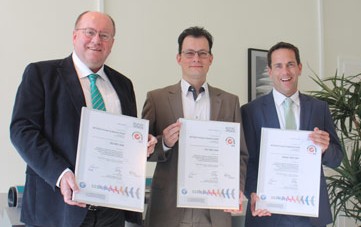NETZSCH gains triple SGS certification
- Like
- Digg
- Del
- Tumblr
- VKontakte
- Buffer
- Love This
- Odnoklassniki
- Meneame
- Blogger
- Amazon
- Yahoo Mail
- Gmail
- AOL
- Newsvine
- HackerNews
- Evernote
- MySpace
- Mail.ru
- Viadeo
- Line
- Comments
- Yummly
- SMS
- Viber
- Telegram
- Subscribe
- Skype
- Facebook Messenger
- Kakao
- LiveJournal
- Yammer
- Edgar
- Fintel
- Mix
- Instapaper
- Copy Link
Posted: 20 March 2015 | NETZSCH Pumps & Systems | No comments yet
NETZSCH Pumps & Systems has been granted three certificates in accordance with OHSAS 18001, ISO 14001 and ISO 9001 by the SGS International Certification Services…


NETZSCH Pumps & Systems has been granted three certificates in accordance with OHSAS 18001, ISO 14001 and ISO 9001 by the SGS International Certification Services. This success was achieved pricipally by NETZSCH’s “Integrated Quality Systems”. The requirements of the internationally recognised DIN EN ISO 14001 and OHSAS 18001 management standards were met, jointly certified and merged with the existing DIN EN ISO 9001-compliant system.


Behind the certifications lie the evidence requirements for quality management (ISO 9001), environmental management (ISO 14001) and health and safety management (OHSAS 18001) systems.
Bert Nowitzki, Manager of Integrated Quality Systems and QM, commented, “providing evidence for these certificates and successfully defending them are of fundamental importance for our continued success in many markets. Above all in the oil and gas industry, but this also plays a major role in sectors such as the chemical and food industry. It was a tremendous internal effort for us. The actions we took included:
- dedicating more than 3,700 working hours
- completing more than 70 large project workshops
- initiating 332 individual measures and sub-projects
- training employees in all areas in 23 themed workshops and courses
- testing and defending our plans in 22 internal and external audits, and many, many more.
At the beginning, we were almost completely focused on meeting the company’s market requirements. However, the change management aspect gradually came to be predominant. Because, in contrast to ISO 9001, ISO 14001 and OHSAS 18001 are almost entirely based on statutory requirements and in addition have a strong concentration on risk assessment and prevention. It may sound extremely simple here, but in day-to-day practice it really is a lot of work.”




